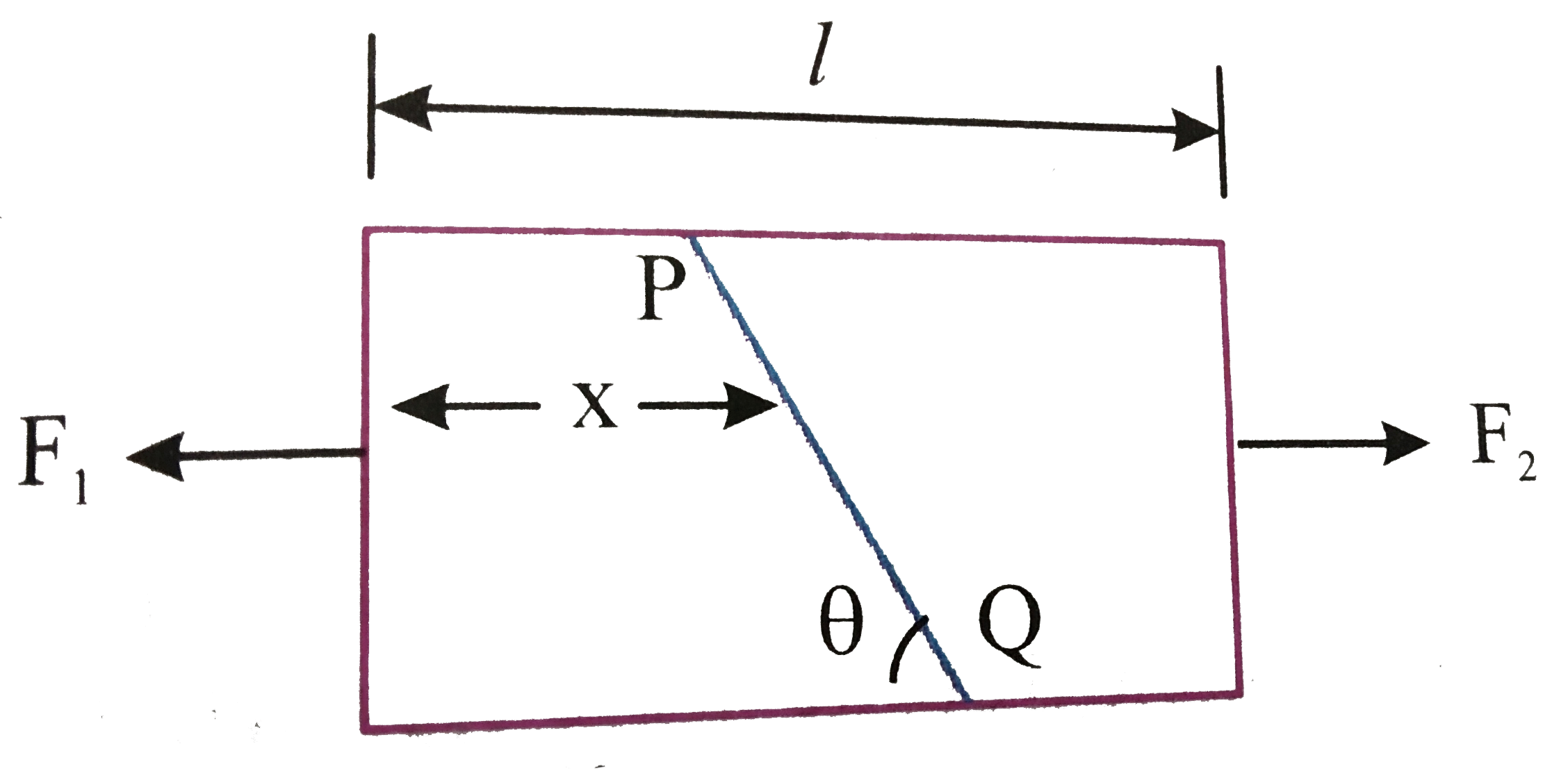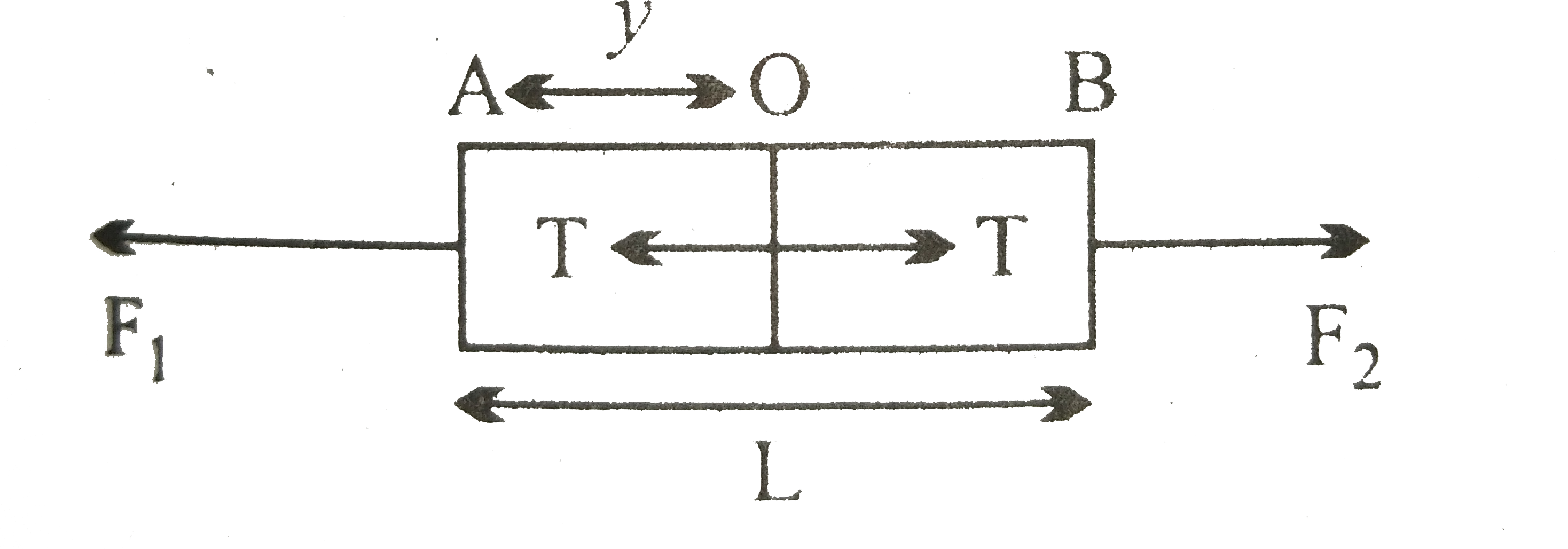A homogeneous rod of length 'L' is acted upon by two forces F1 and F2 applied to its ends and directed opposite to each other. If F2>F1 then with what force 'F' will the rod be stretched at the cross-section at a distance 1 from the end where F1 is applied:
 Solution in Telugu
Solution in Telugu
(F2−F1)1L
(F2−F1)1L+F1
(F2+F1)12L
(F2+F1)12L+F1
The correct Answer is:B
Step by step video & image solution for A homogeneous rod of length 'L' is acted upon by two forces F_(1) and F_2 applied to its ends and directed opposite to each other. If F_(2) gt F_(1) then with what force 'F' will the rod be stretched at the cross-section at a distance 1 from the end where F_(1) is applied: by Physics experts to help you in doubts & scoring excellent marks in Class 11 exams.
Updated on:21/07/2023Topper's Solved these Questions
- NEWTONS LAWS OF MOTION BOOK - AAKASH SERIESCHAPTER - NEWTONS LAWS OF MOTION EXERCISE - ADDITIONAL PRACTICE EXERCISE (LEVEL - II (LECTURE SHEET (ADVANCED)) (Straight Objective Type Questions)
12 Videos
- NEWTONS LAWS OF MOTION BOOK - AAKASH SERIESCHAPTER - NEWTONS LAWS OF MOTION EXERCISE - ADDITIONAL PRACTICE EXERCISE (LEVEL - II (LECTURE SHEET (ADVANCED)) (More than one correct answer Type Questions )
2 Videos
- NEWTONS LAWS OF MOTION BOOK - AAKASH SERIESCHAPTER - NEWTONS LAWS OF MOTION EXERCISE - PRACTICE SHEET (EXERCISE - IV) (LEVEL - II) (Straight Objective Type Questions)
2 Videos
- MOTION IN A STRAIGHT LINEBOOK - AAKASH SERIESCHAPTER - MOTION IN A STRAIGHT LINEEXERCISE - Questions for Descriptive Answers
7 Videos
- OSCILLATIONBOOK - AAKASH SERIESCHAPTER - OSCILLATIONEXERCISE - QUESTIONS FOR DESCRIPTIVE ANSWERS
12 Videos
Similar Questions
A lift of total mass M is raised by cables from rest through a height h . The greatest tension which the cables can safely bear is n Mg. The maximum speed of lift during journey if the ascent is to made shortest time is :
View SolutionA particle is found to be at rest when seen from a frame S1 and moving with a constant velocity when seen from another frame S2
a) Both the frames are inertial
b) Both the frames are non inertial
c) S1 is inertial and S2 is non inertial
d) S1 is non inertial and S2 is inertial
View SolutionIn the figure shown the acceleration of A is, →a=15ˆi+15ˆj then the acceleration of B is: (A remains in contact with B)

View SolutionThree tortoises are located at the vertices of an equilateral triangle whose side equals a They all start moving simultaneously with velocity v constant in modulus with the first tortoise heading continually for the second , the second for the third and the third for the first . They will meet after time
View SolutionThe spring shown in figure is unstretched when a man starts pulling on the cord. The mass of the block is M. If the man exerts a constant force F, find the amplitude and the time period of the motion of the block.

View SolutionA homogeneous rod of length L is acted upon by two forces F_(1) and F_(2) applied to its ends and directed opposite to each other. With what force F will the rod be stretched at the cross section at a distance l from the end where F_(1) is applied?
View SolutionWhat is the tension in a rod of length length L and mass M at a distance y fromF1 when the rod is acted on by two unequal force F1 and F2(<F1) as shown in.

View SolutionTwo forces F1 and F2 act on a thin uniform elastic rod placed in space. Force F1 acts at right end of rod and F2 acts exactly at centre of rod as shown (both forces act parallel to length of the rod).

(i)F1 causes extension of rod while F2 causes compression of rod.
(ii) F1 causes extension of rod and F2 also causes extension of rod.
(iii) F1 causes extension of rod while F2 does not change total length of rod.
The correct order of True/False in above statements is
View SolutionTwo forces F1 and F2 are applied at the ends of a metal rod of Yougn's Modulus Y, length l as shown.

Longitudinal stress at the given cross-section PQ if the cross-section of the rod is A0 and tension is T
View SolutionA thin uniform rod AB of mass 1 kg moves translationally with acceleration a=2m//s^(2) due to two antiparallel forces F_(1) & F_(2) . The distance between the points at which these forces are applied is equal to l=0.2m. If force F-(1)=8N then find the length of the rod in meter
View SolutionFig shows three forces F_(1), F_(2) and F_(3) acting on a rod pivoted at its end. Find the torque of each force about pivot.
View SolutionFrequency of oscillation of a body is 6 Hz when force F1 is applied and 8 Hz when F2 is applied . If both forces F1 and F2 are applied together, then find out the frequency of oscillation.
View Solutionचित्र के अनसार , L लंबाई और M द्रव्यमान वाली छड़ AB के सिरे पर F1, और F2, बल लगाये गये हैं , जहाँ F2<F1. सिरे A से y दूरी पर छड़ में उत्पन्न तनाव की गणना कीजिए ।

View SolutionTwo forces F_(1) and F_(2) ( F_2 gt F_(1)) are applied at the free ends of uniform rod kept on a horizontal frictionless surface. Find tension in rod at a distance x from end ‘A’,
View SolutionThe two ends of a rod of length L and a uniform cross-sectional area A are kept at two temperatures f_(1) and T_(2) rod in a steady state is given by :
View SolutionA homogeneous rod of length 'L' is acted upon by two forces F1 and F2 applied to its ends and directed opposite to each other. If F2>F1 then with what force 'F' will the rod be stretched at the cross-section at a distance 1 from the end where F1 is applied:

View Solution
